Theme Parks & Themed Entertainment
Exploring WDW’s Grand Floridian Resort Hotel
Mouseketrips’ Scott Liljenquist wraps up his debut JHM series by taking us on a tour of Disney World’s flagship resort, the Grand Flo.

Facts and Figures
The flagship resort of all Disney properties is the 867-room Grand Floridian Resort & Spa. Completed in 1988 as the fifth Disney resort, it ushered in Michael Eisner’s “Disney Decade” of building and expansions at Walt Disney World. Inspired by the Hotel de Coronado in San Diego, the Grand Floridian recalls the grand opulence of Victorian-era structures. Its brilliant white exterior, red clay tile roof and extensive Victorian architectural details recall the elegant hotels of the past. It has received AAA and Mobil 4-star ratings, and has been regularly voted one of the top 50 hotels in the world by readers of Conde Nast travel magazine.
As elegant as the Grand Floridian is, however, one has to wonder what would have happened had the Imagineers actually built the resort originally intended for the Grand Floridian’s current site. You see, in the original plans for Walt Disney World there were to have been five resort hotels in the Magic Kingdom area – the Contemporary (which, up until the early 80s, was always intended to be the flagship WDW resort), the Polynesian, the Venetian (to have been located on the shore of Seven Seas lagoon between the Contemporary and the site now occupied by the Ticket and Transportation Center), the Persian (to have been located north of the Polynesian and east of the Magic Kingdom on the northwestern shore of Bay Lake), and the Asian. It was the Asian resort that had been planned, designed, and was almost constructed on the land where the Grand Floridian now resides.
Visitors to the Magic Kingdom from opening day in 1971 to the early 1980s often wondered what that perfectly square, flat, barren, and obviously man-made piece of ground was for that jutted out into Seven Seas lagoon from the western shore. So close was the Asian resort to realization that this prime piece of land was actually cleared and prepared during the initial construction of the Magic Kingdom. In fact, in its annual report for 1972, Disney announced that preparations would begin immediately for construction of the Asian resort, with the resort to have been completed in 1974. Those of you with good memories will even recall that the road on the western side of the Walt Disney World property was originally called Asian way until being renamed Floridian Way upon completion of the Grand Floridian.
So what did we miss out on? Well, the Asian was to have been mainly Thai in theming. A ring of perimeter lodging buildings would have been built on the three sides of the property that adjoined Seven Seas lagoon. Similar in construction to the Polynesian’s longhouses, these accommodations would have featured Asian-style architecture and a majority of water-view rooms. In the central courtyard formed by these buildings would have been a large swimming pool and the focal point of the resort – a central tower building reaching more than 150 feet tall. This square-shaped tower building, with huge A-shaped windows on all four sides, would have housed the lobby, shops, and a signature restaurant with unparalleled views and nightly entertainment.
This all sounds great, you’re thinking to yourself, so what happened? Why aren’t we enjoying nights in Asia now as we do nights in Polynesia or the hotel of the future? Most theories point to an event in the early 70s which had nearly as devastating effect on the Disney company and the travel industry in general as did the events of September 11th. The Arab oil embargo, which created a nationwide energy crisis in 1973, severely curtailed the travel habits of most of WDW’s visitors. Serious declines in visitation led to frequent vacancies at the existing Contemporary and Polynesian resorts. Left without demand for its lodging, Disney had no choice but to put off construction of the Asian. It was not until Michael Eisner and Frank Wells took the reins of the Disney Company in 1984 and realized how underutilized the Florida property was that resort building once again became a priority. Unfortunately, the proposal for an elegant, luxurious, Victorian-style 5-star resort eventually won out over the long-mothballed plans for the Asian, and the site so long intended for a bit of Asia in the World now houses the Grand Floridian Resort and Spa.
All is not lost, however, as the Grand Floridian is a wonderful resort. As the premier destination at Walt Disney World, touches of elegance, luxury, and charm abound at the Grand Floridian. The resort consists of the main building containing the lobby, restaurants, lounges, and shops, 5 outer buildings containing various types of lodging, a large convention and conference center, the spa and health club building, and the wedding pavilion. Each structure is carefully detailed with gabled rooflines, dormers, towers, cupolas, and gingerbread features. The Grand Floridian features a world-class health club and spa, tennis courts, marina, unique shops, convention center, and its own wedding pavilion.
Lodging
Guest rooms at the Grand Floridian are located in one of six buildings on the 39-acre resort site. The main building is five stories tall, and the other buildings range in size from three to five stories. Each of the buildings offers its own benefits and drawbacks, with some buildings nearer some resort features and destinations than others. All buildings have a mix of garden view and water view rooms, with the water view rooms being the most popular and, of course, the most expensive.
Several different room types are available at the Grand Floridian. Standard rooms are about average size for Walt Disney World resorts. Dormer rooms are located on the top floors of the buildings, and feature vaulted ceilings and dormer windows (easily identified from the exterior of the building). Lodge tower rooms are located in the main building in the semi-circular tower-type structures at the corners of the buildings. In addition to the standard size room, the lodge tower room features an additional sitting area in the semi-circular portion of the room which includes a sofa and second television. Honeymoon suites are available with or without Jacuzzi baths in the main building, and several suites of varying sizes and opulence are also located in the main building.
Rooms in the main building are closest to the restaurants, shops, and monorail station. The convention center is most easily accessed from the main and Sago Cay buildings. Nearest the marina are Sugarloaf Key and Conch Key buildings. Access to the boat launch ramp is closest to Conch Key and Boca Chica buildings. Boca Chica and Big Pine Key buildings are closest to the quiet pool, and Big Pine Key and the Main building are nearest the new Beach pool and spa & health club building. Most of the suites and concierge service rooms are located in the main building. Some concierge services are now also being offered in the Sugarloaf Key building.
Dining
Dining at the Grand Floridian is one of the highlights of the resort, with several different options for all tastes and budgets. The only restaurant at Walt Disney World to require formal attire is Victoria & Albert’s in the main building of the resort. The premier dining experience at the Grand Floridian, Victoria & Albert’s nightly serves a full, custom-designed 5 course menu specially selected by the chef. Reservations are required, and they mean it: no-shows are charged cancellation fees. The award-winning cuisine and accompanying wines are hand-selected nightly and prepared to order. Very, very expensive, but well worth doing at least once to see how the upper crust dine.
Not quite as fancy, but still an upscale restaurant is Citrico’s, located in the main building. Citrico’s serves Mediterranean-inspired salads, seafood, pasta, and meat dishes. The food here is quite good, but I have found the service to be somewhat spotty.
Narcoossee’s, located in its own building on the shores of Seven Seas lagoon next to the Conch Key building, is the Grand Floridian’s fine steak house. This restaurant, which has a wonderful atmosphere (especially when it’s warm and the windows are open to the outside) is noted for its steak, chicken, and seafood.
1900 Park Fare, located on the first floor of the main building, is the location of the Grand Floridian’s buffet. A daily character breakfast is found here, with visits from Mary Poppins, Alice in Wonderland, and other Disney characters. A Disney character dinner buffet with Pooh and Friends is also offered.
The Grand Floridian Café, also located on the first floor of the main building, is a more casual dining experience featuring American-style dishes of chicken, salad, pasta, hamburgers, sandwiches, and seafood. While still not inexpensive, this is a great place to catch a quick breakfast or lunch.
Gasparilla Grill & Games is the Grand Floridian’s counter-service restaurant, and can be accessed only from the outside of the main building. It’s undoubtedly the best of the WDW counter service restaurants, and I have found the food here to be consistently better than that found at any other resort. The usual fare of hamburgers, hot dogs, and pizza can be found, along with deli sandwiches, fresh salads, and fresh bakery items.
Transportation
Monorail service is offered from the monorail station located on the second floor of the main building. The resort monorail departs from this station for the Magic Kingdom, and then continues on to the Contemporary, the Ticket and Transportation Center, and the Polynesian. Epcot is accessible by riding the resort monorail to the Ticket and Transportation Center and switching there to the Epcot monorail.
Bus transportation to Disney-MGM Studios, Animal Kingdom, Downtown Disney, and the Ticket and Transportation center is available from bus stops located just outside of the main building entrance.
Boat service is available from the water launch dock next to Narcoossee’s with service to the Magic Kingdom and Polynesian.
Activities
There are two swimming pools at the Grand Floridian. A large, free-form quiet pool is located in the central courtyard between the Boca Chica, Big Pine Key, and Sugar Loaf Key buildings. There is ample patio space here and an abundance of lounge chairs for those inclined to sunbathe. Completed in 2001, the Beach pool is located at the southern end of the resort between the main building and the wedding pavilion. This new pool features a zero-entry area from the beach of Seven Seas lagoon, a man-made mountain, waterfall and waterslide.
True to its name, the Grand Floridian Resort and Spa features a world class spa located to the south of the main building near the new Beach pool. A fitness facility includes the very latest in fitness machines and equipment, and personal trainers are available to assist you in designing your ultimate workout. A wide variety of spa treatments is also available, including facials, massages, full-body skin treatments, water therapies, manicures, pedicures, and more. If you really want to make points with that significant other, gentlemen, schedule a whole or half day spa treatment with a sampling of several spa services. Trust me, it works!
An arcade is located in Gasparilla Grill & Games in the main building. Somewhat on the small side, this arcade features a fairly limited selection of video games, arcade games, and air hockey tables.
The Grand Floridian’s marina is located at the north end of the property and offers rentals of pontoon boats, sailboats, canopy boats and the ubiquitous water mice. In addition, the Grand Floridian offers for charter their 44-foot yacht Grand 1. It can be hired by groups of 2 to 12 people, and includes a captain and deckhand. Bring your wallet – the yacht goes for $350 per hour.
Two clay-court tennis courts are located adjacent to the health club and spa building. Tennis equipment can be rented at the health club, and professional instruction is available by appointment.
Two great activities are available for kids at the Grand Floridian. Disney’s Pirate Adventure departs from the marina every Monday, Wednesday, and Thursday. This fun-filled program, just for children ages 4-10, takes kids on a treasure hunt around seven seas lagoon. Each child is given a pirate hat (complete with Mickey ears, of course) after which they board a boat, complete with pirate flag, and cruise to the different resort marinas around Seven Seas lagoon and Bay Lake hunting for pirate treasure. The two-hour adventure includes lunch.
The Wonderland Tea Party is held Monday through Friday at 1:30 pm in the main building for children ages 3-10. Parents are not invited. Characters from Alice in Wonderland, including Alice herself, host a tea party for the kids complete with snacks, games, songs, crafts, and, of course, tea with Alice and her friends. Tea lasts for approximately one hour.
Not to be left out, adults too can enjoy tea at the Grand Floridian. Afternoon tea is served daily from 3pm- 6pm in the Garden View lounge. Tea is accompanied by a wonderful selection of pastries and fresh fruit.
Finally, if you’re really bored, why don’t you take the afternoon off and get married? The Grand Floridian has its very own Fairytale Wedding Pavilion located on a peninsula extending into the Seven Seas lagoon. From this extremely picturesque spot, you can exchange vows with Cinderella Castle in the background. Full-service wedding planning and coordination services are available.
Insider’s Tips and Tricks
As mentioned before, the Grand Floridian’s 44-foot yacht, the Grand 1 is available for hire. If you can get a large enough group together to split the cost, charter the boat for the evening and enjoy a gourmet dinner aboard, and then watch the Magic Kingdom’s fireworks show while floating in the middle of Seven Seas lagoon. The fireworks look even more brilliant when they are reflected back from the water.
If you have a lagoon-view room booked, be sure to request a dormer room. These rooms are located on the top floor of all the buildings and feature vaulted ceilings inside. Although the rooms are not any larger than the standard rooms, they seem quite a bit larger and, in my opinion, more comfortable with the high ceilings. In addition, dormer rooms are the only standard-level rooms with private balconies. Non-dormer rooms on the lower floors all have shared balconies.
If you need a little extra room, book a lodge tower room. These rooms have an additional sitting/living area that extends into the round tower-type structures on the main building. This additional room is great to have if you need to squeeze in an additional person or just want to stretch out a little bit.
If you have booked a water view room and want to obtain a view of the Magic Kingdom, Cinderella Castle, and the MK fireworks, your best bet is to ask for accommodations in the Boca Chica building. All of the rooms on the east side of this building have fantastic views of the Magic Kingdom and Seven Seas lagoon. In addition, the Electric Water Parade will stop right outside your window for its nightly performance. However, if you’re feeling really lucky and a view of the MK is of paramount importance to you, request a north-end room in either the Conch Key or Sago Cay buildings. These rooms have by far the best view of the Magic Kingdom and the Castle, but there aren’t very many of them, and they are in high demand and very difficult to get.
Sign your kids up for the Pirate Adventure and Wonderland Tea Party. Both of these programs are absolutely fantastic and earn rave reviews. In addition to giving you an hour or two for sunning, sleep, or spa treatments, the kids will have a ball and will most likely point to this experience as one of the high points of their vacation. The staff is well-trained and enthusiastic, and really have a good time interacting with each child to make sure they have a great time.
Be sure to experience the afternoon tea. It’s a cultural thing you’ll be glad you did at least once in your life, and you may find that you’ll be wanting to go back. The food served at tea is fantastic, with delicious fresh pastry and fruit. Well worth an hour of your afternoon.
Don’t fret if you can’t afford a water view room. Although a view of the lagoon is desirable, there really are only a few rooms in the whole resort with really rotten views. Most garden view rooms look out on to the impeccably maintained landscaping and provide excellent views. I do not mind a garden view room at the Grand Floridian near as much as I do at other resorts.
A meal at Victoria & Albert’s is a don’t miss. While I would not recommend it for every visit, it’s an experience that is unlike any other. The food and drink are absolutely wonderful, and the service is what you’d expect for a premier dining location. You’ll never feel so pampered and well-served as you do during your meal here.
The new Beach pool is a real gem and is often overlooked on the list of great WDW pools. That’s good for you, because it means that it’s usually not all that crowded. The fact that not many people know about it, coupled with the fact that the Grand Floridian attracts a more adult clientele, means that an enjoyable and fairly uncrowded afternoon can be spend riding the waterslide and splashing in the waterfall.
Another great fireworks-watching location is from your table at Narcoossee’s. Book a priority seating for a late dinner or maybe just for dessert, and enjoy a good meal with an outstanding view of the Magic Kingdom, the boat traffic on Seven Seas lagoon, and the fireworks show.
Television & Shows
The Untold Story of Super Soap Weekend at Disney-MGM Studios: How Daytime TV Took Over the Parks
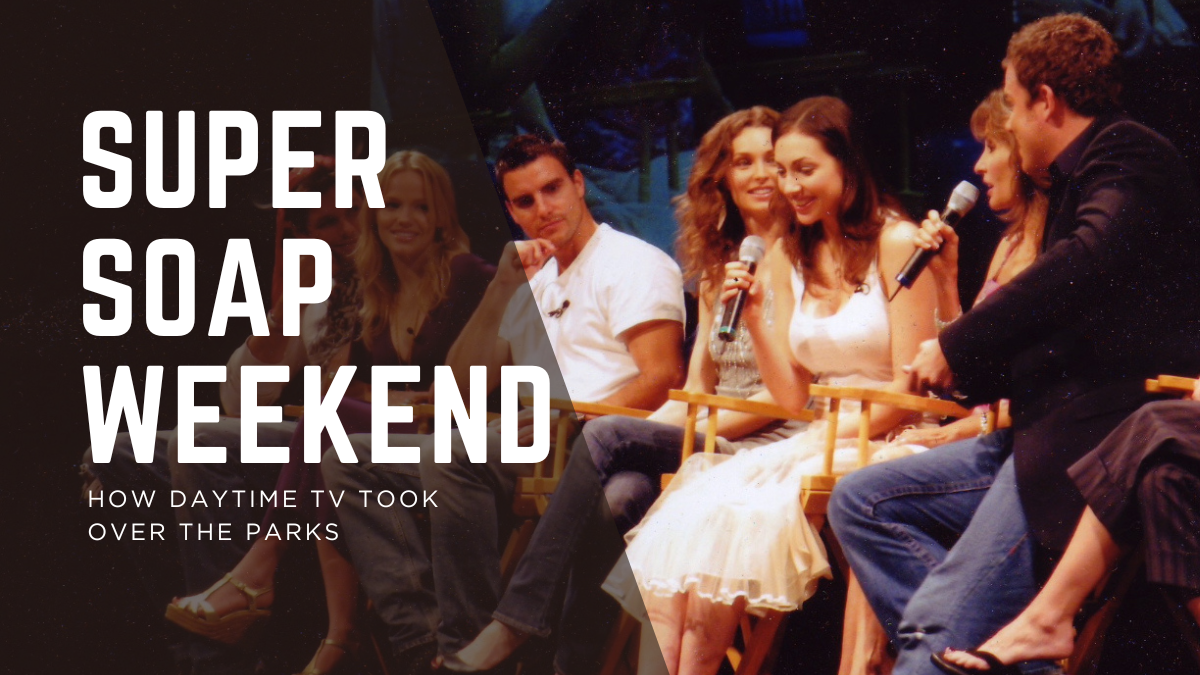
A long time ago in a galaxy that … Well, to be honest, wasn’t all that far away. This was down in Florida after all. But if you traveled to the WDW Resort, you could then experience “Star Wars Weekends.” Which ran seasonally at Disney’s Hollywood Studios Disney World from 1997 to 2015.
Mind you, what most folks don’t remember is the annual event that effectively plowed the road for “Star Wars Weekends.” Which was “Super Soap Weekend.” That seasonal offering — which allowed ABC soap fans to get up-close with their favorite performers from “All My Children,” “General Hospital,” “One Life to Live” and “Port Charles” — debuted at that same theme park the year previous (1996).
So how did this weekend-long celebration of daytime drama (which drew tens of thousands of people to Orlando every Fall for 15 years straight) come to be?
Michael Eisner’s Daytime TV Origins and a Theme Park Vision
Super Soap Weekend was the brainchild of then-Disney CEO Michael Eisner. His career in media began with short stints at NBC and CBS, but it truly took off in 1964 when he joined ABC as the assistant to Leonard Goldberg, who was the network’s national programming director at the time.
Eisner quickly advanced through the ranks. By 1971, he had become Vice President of Daytime Programming at ABC. That meant he was on the scene when One Life to Live joined the lineup in July 1968 and when All My Children made its debut in January 1970. Even after being promoted to Senior Vice President of Prime Time Programming in 1976, Eisner stayed close to the daytime division and often recruited standout soap talent for ABC’s primetime shows.
Fast forward nearly two decades to July 31, 1995. The Walt Disney Company announced that it would acquire ABC/Cap Cities in a $19 billion deal. Although the acquisition wasn’t finalized until February 1996, Eisner was already thinking ahead. He wanted to use the stars of All My Children, One Life to Live, and General Hospital to draw people to Disney’s theme parks.
He had seen how individual soap stars were drawing huge mall crowds across America since the late 1970s. Now he wanted to bring dozens of them together for something much bigger.
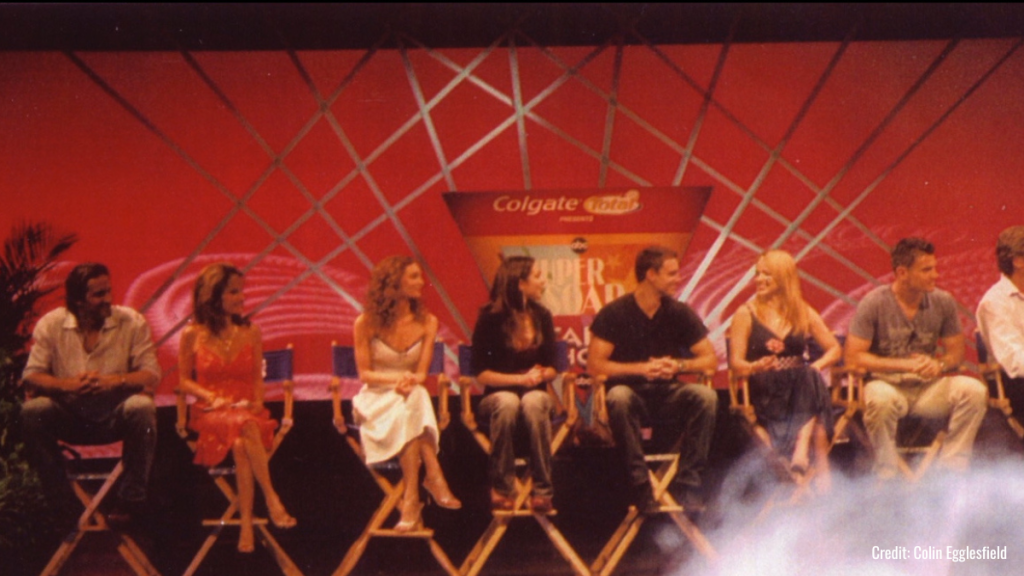
Super Soap Weekend Takes Over Disney-MGM Studios
The very first Super Soap Weekend was announced in June 1996, just a few months after the ABC deal closed. The event was scheduled for October 19 and 20 at Disney-MGM Studios and was a massive success.
The weekend featured panel discussions, autograph sessions, and photo opportunities with the stars of ABC’s daytime dramas. Thousands of fans packed the park for the chance to meet their favorite actors. Due to the overwhelming response, the event became an annual tradition and was eventually moved to Veterans Day weekend each November to better accommodate attendees.
Longtime fans like Nancy Stadler, her mom Mary, and their close friend Angela Ragno returned year after year, making the event a personal tradition and building lifelong memories.
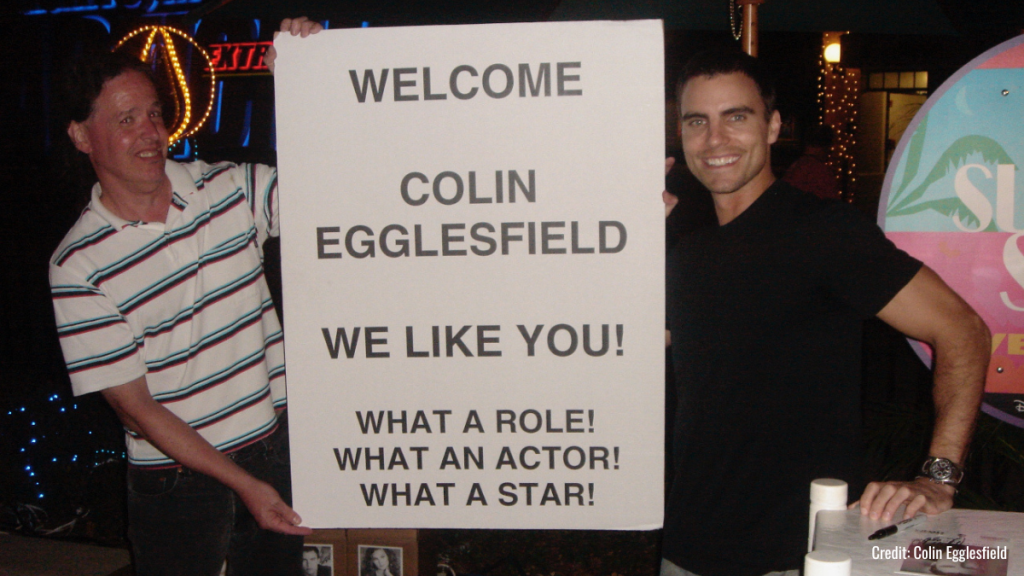


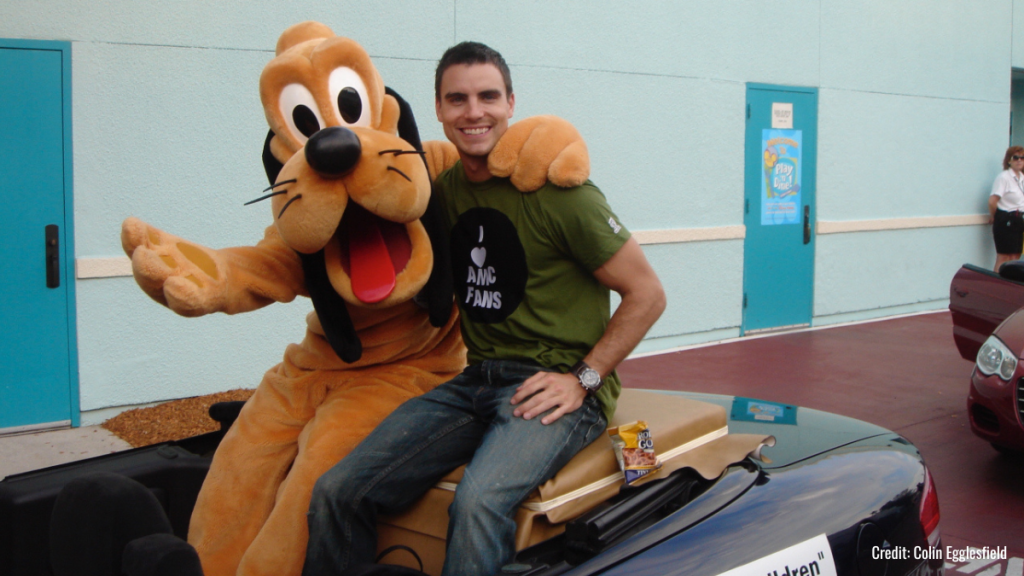
West Coast Events and the ABC Soap Opera Bistro
Disney even tried to recreate the event out west. Two Super Soap Weekends were held at Disneyland Resort, one in April 2002 and another in June 2003.
At Disney’s California Adventure, Eisner also introduced the ABC Soap Opera Bistro, a themed dining experience that opened in February 2001. Guests could dine inside recreated sets from shows like General Hospital and All My Children, including Kelly’s Diner and the Chandler Mansion. The Bistro closed in November 2002, but for fans, it offered a rare opportunity to step into the world of their favorite soaps.
SOAPnet, Port Charles, and the Expansion of Daytime TV at Disney
Eisner’s enthusiasm for soaps extended beyond the parks. In January 2000, he launched SOAPnet, a cable channel dedicated to prime time replays of ABC’s daytime dramas.
During his time at Disney, General Hospital also received a spin-off series titled Port Charles, which aired from June 1997 to October 2003. The show leaned into supernatural plotlines and was another example of Eisner’s commitment to evolving and expanding the soap genre.
The Final Curtain for Super Soap Weekend
In September 2005, Eisner stepped down after 21 years as head of The Walt Disney Company. Bob Iger, who had previously served as President of ABC and Chief Operating Officer of ABC/Cap Cities, took over as CEO. While Iger had deep ABC credentials, he didn’t share Eisner’s passion for daytime television.
In the fall of 2008, Disney hosted the final Super Soap Weekend at what was then still called Disney-MGM Studios. That same year, the park was rebranded as Disney’s Hollywood Studios, and Disney began shifting away from television-focused experiences.
Within the next five years, the rest of Eisner’s soap legacy faded. One Life to Live was canceled in January 2012. SOAPnet was rebranded as Disney Junior in February 2013. Later that year, All My Children ended its 41-year run on ABC.
Only General Hospital remains on the network today, the last standing soap from the golden age of ABC Daytime.
A New Chapter for Daytime TV and Super Soap Fans
The soap genre may have faded from its former glory, but it’s not gone. On February 24, 2025, CBS premiered a brand-new daytime drama called Beyond the Gates, marking the first new soap launch in years.
Meanwhile, All My Children alum Kelly Ripa has been actively working on a revival. In September 2024, she mentioned a holiday-themed movie set in Pine Valley that would bring back many original cast members. The project was in development for Lifetime, though its current status is unclear.
And what about Super Soap? Fans like Nancy and Angela still hope Disney will bring it back. Even if it only featured the cast of General Hospital, it would be a welcome return for longtime viewers who miss that one weekend a year where the magic of Disney collided with the drama of daytime TV.
If you want to hear firsthand what it was like to be part of Super Soap Weekend, be sure to listen to our I Want That Too podcast interview with actor Colin Egglesfield. He shares behind-the-scenes memories from his days as Josh Madden on All My Children and what it meant to be part of one of the most unique fan events in Disney park history.
History
The Super Bowl & Disney: The Untold Story Behind ‘I’m Going to Disneyland!’

One of the highlights of the Super Bowl isn’t just the game itself—it’s the moment when the winning quarterback turns to the camera and exclaims, “I’m going to Disney World!” This now-iconic phrase has been a staple of post-game celebrations for decades. But where did this tradition begin? Surprisingly, it didn’t originate in a stadium but at a dinner table in 1987, in a conversation involving Michael Eisner, George Lucas, and aviation pioneers Dick Rutan and Jeana Yeager.

The Unlikely Beginning of a Marketing Sensation
To understand the origins of this campaign, we have to go back to December 1986, when the Rutan Voyager became the first aircraft to fly around the world without stopping or refueling. Pilots Dick Rutan and Jeana Yeager completed the nine-day journey on December 23, 1986, flying over 26,000 miles before landing at Edwards Air Force Base. Their historic achievement earned them national recognition, and just days later, President Ronald Reagan awarded them the Presidential Citizen Medal at the White House.
Meanwhile, Disney was gearing up for the grand opening of Star Tours at Disneyland, set for January 12, 1987. Following its usual playbook of associating major theme park attractions with real-world pioneers, Disney’s PR team invited astronauts Gordon Cooper and Deke Slayton to the launch event. But in a twist, they also invited Rutan and Yeager, who were still making headlines.
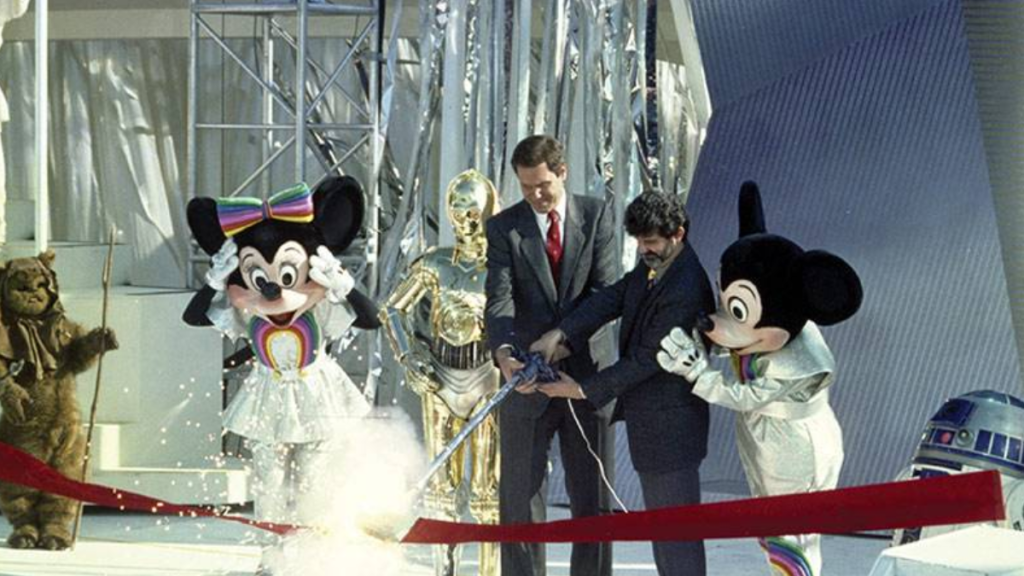
A Dinner Conversation That Changed Advertising Forever
After the Star Tours opening ceremony, a private dinner was held with Disney CEO Michael Eisner, George Lucas, and Eisner’s wife, Jane. During the meal, Eisner asked Rutan and Yeager, “You just made history. You traveled non-stop around the planet on a plane without ever refueling. How are you ever going to top that, career-wise? What are you two gonna do next?”
Without hesitation, Jeana Yeager replied, “Well, after being cramped inside that tiny plane for nine days, I’m just glad to be anywhere else. And even though you folks were nice enough to fly us here, invite us to your party… Well, as soon as we finish eating, I’m gonna go over to the Park and ride some rides. I’m going to Disneyland.”
Jane Eisner immediately recognized the power of Yeager’s statement. On the car ride home, she turned to Michael and said, “That’s a great slogan. I think you should use that to promote the theme parks.” Like many husbands, Michael initially dismissed the idea, but Jane persisted. Eventually, Eisner relented and pitched it to his team.
The Super Bowl Connection
With Super Bowl XXI just around the corner, Disney’s PR team saw an opportunity. The game was set for January 25, 1987, at the Rose Bowl in Pasadena—just miles from Disney Studios. What if they convinced the winning quarterback to say, “I’m going to Disneyland” live on-air?
Disney quickly struck a deal with both quarterbacks—Phil Simms of the New York Giants and John Elway of the Denver Broncos—offering each $75,000 to deliver the line if their team won. Simms led the Giants to victory, making history as the first athlete to say, “I’m going to Disney World!” on national television.
A Marketing Triumph
That year’s Super Bowl had the second-highest viewership in television history, with 87 million people watching Simms say the famous line. The next day, Disney turned the clip into a national commercial, cementing the phrase as a marketing goldmine.
Since then, “I’m going to Disneyland” (or Disney World, depending on the commercial) has been a staple of championship celebrations, spanning the NFL, NBA, and even the Olympics. What started as a casual remark at dinner became one of the most successful advertising campaigns in history.
A Lasting Legacy
Jane Eisner’s keen instinct and Disney’s ability to act quickly on a great idea created a tradition that continues to captivate audiences. The “I’m going to Disneyland” campaign remains a testament to the power of spontaneous inspiration and smart marketing, proving that sometimes, the best ideas come from the most unexpected places.
To learn more about Disney’s ties to the world of sports, check out I Want That Too: A Disney History and Consumer Product Podcast.
Television & Shows
How the Creators of South Park Tricked A-List Celebrities to Roast Universal – “Your Studio & You”
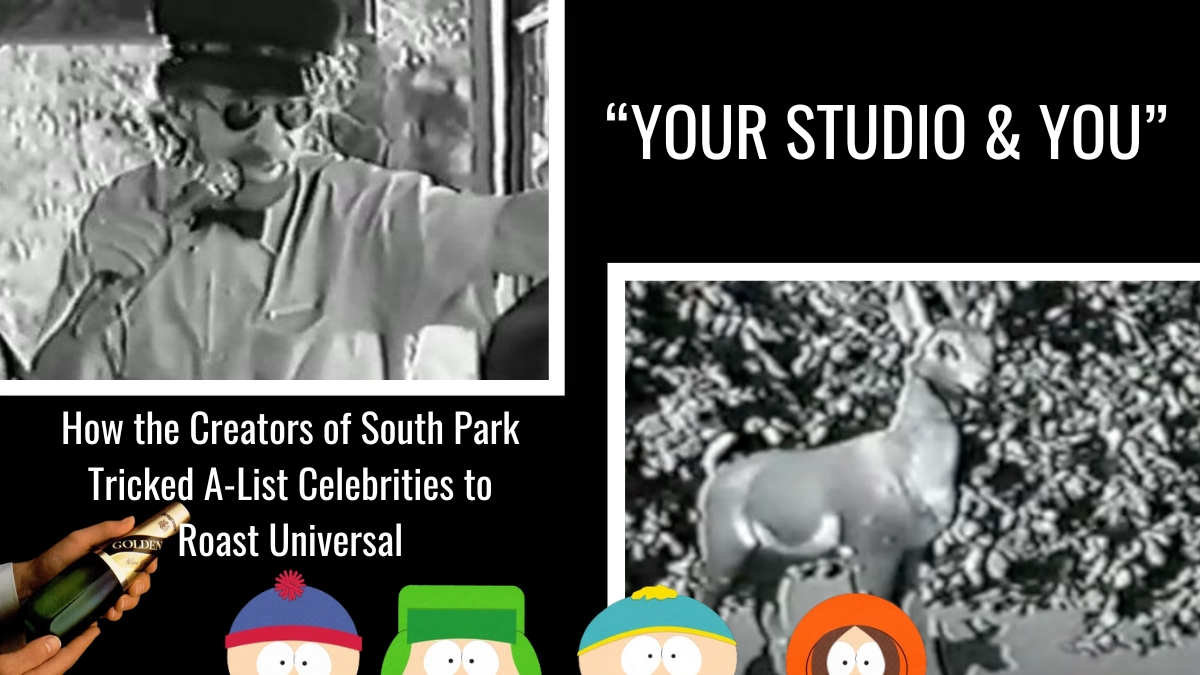
Universal Studios has a rich and storied history, but few moments are as peculiar—and as hilariously cutting—as the creation of Your Studio & You. This 14-minute parody film, commissioned in 1995 to celebrate Universal’s new ownership under Seagram’s, brings together an all-star cast, biting humor, and the unmistakable comedic fingerprints of Matt Stone and Trey Parker.
Long before South Park debuted on Comedy Central in 1997, Stone and Parker were already carving out a reputation for their irreverent style, and Your Studio & You perfectly encapsulates their knack for turning even the most corporate project into something delightfully subversive.
Matt Stone & Trey Parker Before South Park
Stone & Parker were already known out in Hollywood as funny guys. Thanks largely to “The Spirit of Christmas,” which was this video greeting card that they’d crafted for a Fox executive – who then distributed this infamously funny thing (which had Our Lord Jesus Christ & Santa Claus literally duking it out for the holiday affections of Cartman, Kenny, Stan & Kyle) to friends & family.
This was the early 1990s. No internet. Each copy of “The Spirit of Christmas” was made on VHS tape and then mailed. Went viral the old-fashioned way. It’s rumored that George Clooney made over 300 copies of “The Spirit of Christmas” and passed these VHS taps along to friends and family.
Things didn’t move as fast as they do today. “The Spirit of Christmas” still became a sensation out West.
Zucker Brothers
Matt & Trey also had other supporters in the entertainment industry. Among them David Zucker, who was one of the members of ZAZ (i.e., Zucker Abrahams Zucker), the talented trio that made “Airplane!” in 1980, “Top Secret!” in 1984 and the three “Naked Gun” movies.
- The original “Naked Gun” in 1988
- “Naked Gun 2 & 1/2 : The Smell of Fear” in 1991
- and “Naked Gun 33 & a 1/3: The Final Insult” in 1994
All five of these parody films had been made for Paramount Pictures. But in the Late Winter / Early Spring of 1995, Universal had persuaded the Zucker Brothers to come over and set up shop in a bungalow on their lower lot. With the hope that – at some point further on down the line – David & his brother Jerry would start making funny films for Universal.

And it’s during this same window of time (We’re now talking April of 1995) that news breaks that Seagrams (Yep, the adult beverage company. Who – at the time – was making an absolute fortune on the sales of wine coolers) was about to buy a majority stake in MCAUniversal. We’re talking control of 80% of that company’s stock. Which would effectively make Seagrams the new owners of Universal Studios.
Edgar Bronfman
And Edgar Bronfman – the owner of Seagrams – knew that Universal had had a tough time with its previous owners – which had been the Matsushita Electric Industrial Co. of Japan. Matsushita had bought MCA back in November of 1990 for $7.5 billion but had never really understood the entertainment industry.
This is why – after repeatedly butting heads with Lew Wasserman & Sidney Sheinberg (i.e., the heads of Universal Studios & the Universal theme park respectively) when it came to creative control of this company – Matsushita decided to wash it hands of the entire enterprise. Agreeing to sell their holdings in MCA to Seagrams for $5.7 billion (effectively taking a nearly $2 billion loss on this investment).
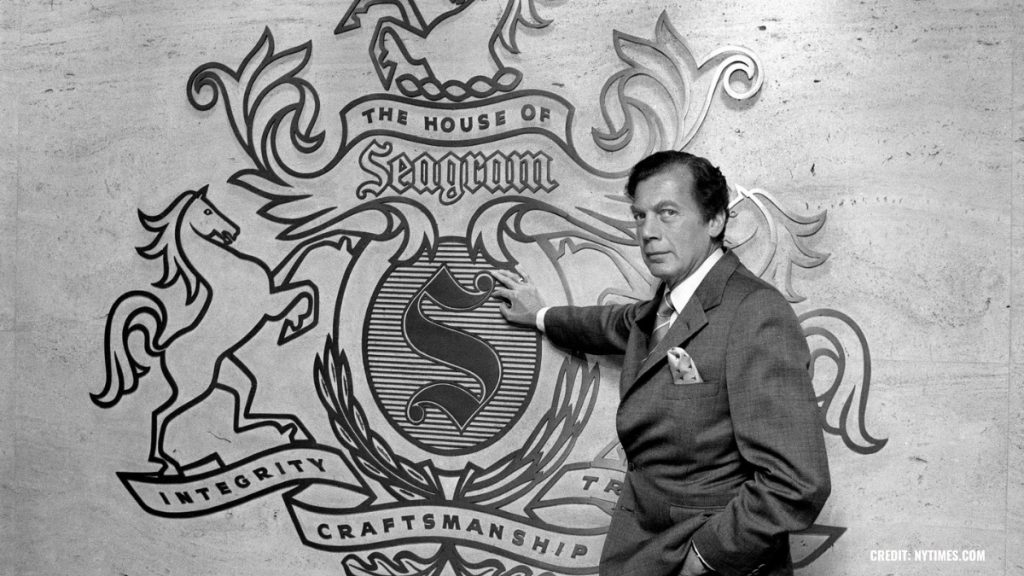
And Bronfman … He knew that some bad feeling had developed between Hollywood’s creative community and the Japanese owners of Universal. The thinking was that executives at Matsushita Electric had just not gotten what it took to make movies & TV shows.
And Edgar? Right from the get-go, he wanted to show that Seagrams was NOT going to be Matsushita Electric Redux. Bronfman was looking for a way to send a clear message to Hollywood’s creative community that Universal’s new owners got it. That they were willing to work with Hollywood to make the best possible movies & TV shows at Universal.
And how did Edgar decide to get this message across? By making a funny movie.
Zucker Commissions Trey Parker for “Your Studio & You”
Mind you, Bronfman himself didn’t make this film. The owner of Seagrams reached out to David Zucker. Who – after initially agreeing to produce this introduction-to-Universal film – then farmed out the production of the actual project to Trey Parker. Who – just two days before shooting was supposed to star on the Universal Lot – persuaded Matt Stone to come help him on this project.
Which brings us to “Your Studio and You.” Which is a parody of an educational film from the 1950s, right down to being shot in black & white and featuring a very generic soundtrack.
Now what’s amazing about watching “Your Studio and You” today is that this 14-minute-long film features some of the biggest names working in Hollywood back in the mid-1990s. We’re talking about people like recent Golden Globe winner Demi Moore, Sylvester Stallone, Michael J. Fox and Angela Lansbury. Not to mention two of the most powerful men in all of Hollywood, Steven Spielberg & Jeffrey Katzenberg.
And what’s especially interesting about watch “Your Studio and You” is that – as you watch these performers go through their paces in this motion pictures (which – most of the time – involves doing some innocuous task while holding a Seagram’s wine cooler) – you often get the feeling that this star is not in on the gag.
So how did Matt & Trey get away with this? Simple. There was never actually a script for “Your Studio and You.”
Filming “Your Studio & You” at Universal Studios Hollywood
Mind you, David Zucker would always insist that there was. Especially when he’d phone up celebrities on the Universal Lot and say “Hey, I’m sending over a couple of college kids later today. They’re working with me on a new parody film. It’s something that we’re doing for the new owners of Universal. I need just a half hour of your time. We’re shooting something special for the party we’ll be holding when the Seagrams people first arrive at the Studio. Absolutely. You’ll definitely get an invite to that party. So can I count on you to help these kids out? Beautiful. They’ll be over there later this morning.”
And then Matt & Trey would show up and say “… Dang, Miss Lansbury. We’re sorry. We must have left our copy of the ‘Your Studio and You’ script back in our office. Which is clear on the other side of the Lot. So – rather than waste your time – why don’t we do this instead? Follow us over to the Psycho House. Where we’re then going to get footage of you painting the front porch on Mother Bates’ house while you say ‘Gosh, with all of the wonderful improvements going on around here, everyone is going to want to work at Universal.’ Oh, and can we also get you to wear this button on the front of your blazer which reads ‘Universal is A-OK’ ? “

And over & over again, the biggest names who were working for Universal at that time took part in the production of “Your Studio & You” because A) David Zucker vouched for Matt Stone & Trey Parker and B) this was something that was being made for the new owners of Universal. And it’s just natural to want to get in good with the new boss.
Steven Spielberg, Jeffery Katzenberg, and Jaws
But no one at Universal anticipated that “Your Studio & You” would wind up being as sharp edged as the finished product turned out to be. I mean, it’s one thing to bite the hand that feeds you. But “Your Studio & You” ? It doesn’t just bite the hand. It takes the hand off at the wrist.
It’s a brutally funny film. With one of the meanest moments reserved for Steven Spielberg, who plays a driver on the Universal Studio Tour who’s trying to persuade a tram full of bored tourists (one of whom is played by Jeffery Katzenberg) that the “Shark Attack” scene down by Jaws Lagoon is actually exciting.
Spielberg actually says lines like “ … Whoa, whoa. What is going on here? Ladies and gentlemen, this never happens. Look out! It’s a shark! Whoa, that is one big scary shark.”
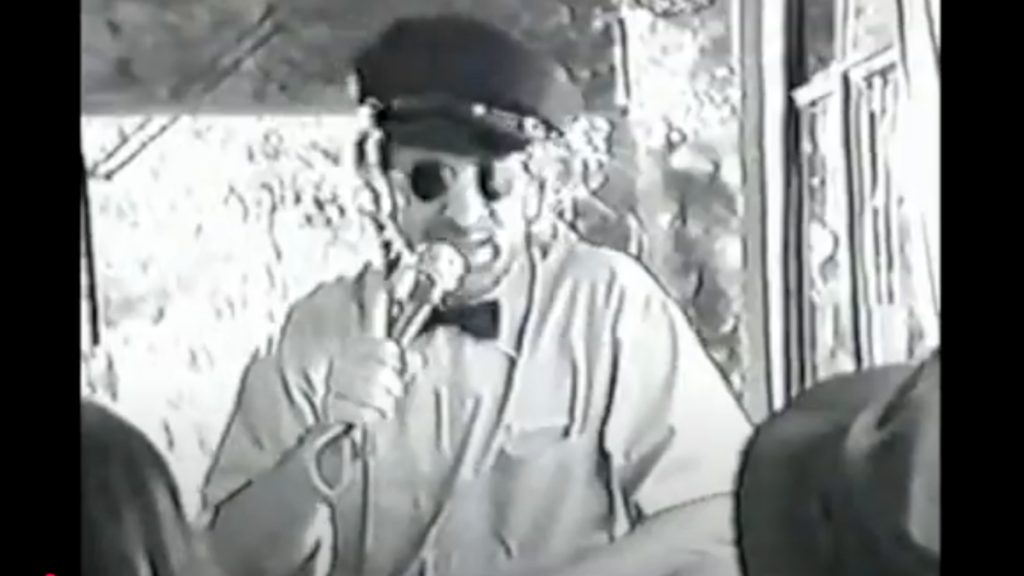
Mind you, as footage of this mechanical shark repeatedly coming up out of the water is shown, “Your Studio & You” ‘s off-screen narrator (who is voiced by Trey Parker says):
“But what about tomorrow? If we don’t keep in step with the times, things that were once neat and thrilling can become old and stupid.”
“Your Studio & You” Reception
This film was supposed to be shown only once at the welcoming party for Seagrams executive on the Universal Lot. And I’m told that – when Edgar Bronfman saw the finished product at that party – he reportedly turned to David Zucker and said “ … That’s a little more mean-spirited that I think it needed to be.”
And with that, “Your Studio & You” was supposed to go back into the Universal vault, never to be seen again. But when “South Park” debuted on Comedy Central in August of 1997 and then became a sensation for its biting humor, there was suddenly a lot of interest in what else Matt & Trey had done. Which is why copies of “The Spirit of Christmas” began to circulate. And – over time – copies of “Your Studio & You” began to bubble up.
Which – as Stone & Parker have repeatedly pointed out – was just not supposed to happen. Largely because none of the celebrities who appeared in “Your Studio & You” had never signed releases for Universal’s legal department. Because – again – this was for a movie that was only going to be shown once at a private function on the Universal Lot.
Matt mentioned (as part of a career retrospective at the Paley Center in LA back in 2000) that “ … they wouldn’t even let us keep a copy of the finished film.”
It’s a funny but brutal movie. And worth taking a look at today especially if you’re a theme park history buff because it shows Universal Studios Hollywood’s “Jurassic Park: The Ride” still under construction on the Lower Lot. That attraction would finally open to the public in June of 1996.
“Your Studio & You” became a lot easier to see after Seagrams sold off its share of Universal to Vivendi in 2000. Copies began propagating online after that. Though Universal Legal will periodically make an effort to get the latest copy of “Your Studio & You” taken off the Internet because – again – none of the performers who appear on camera ever signed the proper releases and/or were paid for their efforts.
That said, if you’re up for a mean-spirited laugh, “Your Studio & You” is well worth 14 minutes of your time. That said, once you watch this thing, be warned:
- You’re immediately going to be thirsty for a Seagram’s wine cooler
- And you’re going to have a sudden desire to go out & buy a porcelain deer.
-

 Theme Parks & Themed Entertainment8 months ago
Theme Parks & Themed Entertainment8 months agoDisney’s Forgotten Halloween Event: The Original Little Monsters on Main Street
-

 Theme Parks & Themed Entertainment8 months ago
Theme Parks & Themed Entertainment8 months agoThe Story of Mickey’s Not-So-Scary Halloween Party: From One Night to a Halloween Family Tradition
-

 Film & Movies8 months ago
Film & Movies8 months agoHow “An American Tail” Led to Disney’s “Hocus Pocus”
-

 Theme Parks & Themed Entertainment6 months ago
Theme Parks & Themed Entertainment6 months agoDisney and Macy’s 90-Year Thanksgiving Day Parade Partnership: From Mickey’s First Balloon to Minnie’s Big Debut
-

 Television & Shows4 months ago
Television & Shows4 months agoHow the Creators of South Park Tricked A-List Celebrities to Roast Universal – “Your Studio & You”
-

 History3 months ago
History3 months agoThe Super Bowl & Disney: The Untold Story Behind ‘I’m Going to Disneyland!’
-

 Podcast1 month ago
Podcast1 month agoEpic Universal Podcast – Aztec Dancers, Mariachis, Tequila, and Ceremonial Sacrifices?! (Ep. 45)
-

 Television & Shows3 weeks ago
Television & Shows3 weeks agoThe Untold Story of Super Soap Weekend at Disney-MGM Studios: How Daytime TV Took Over the Parks







